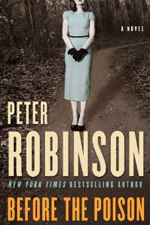Peter Robinson: Before the Poison
Peter Robinson is one of the most intellectual of all mystery writers – and I’m including P.D. James, Ruth Rendell and the late, lamented Reginald Hill in my assessment. One of his recent books, All the Colors of Darkness, was a take on Othello and its theme of jealousy. This novel, while not a part of his now classic Inspector Banks series, is still a thoughtful and compelling novel, based not on Shakespeare, but on the classic film Laura.
 While Robinson has forsaken some of that film’s pop sensibility and sense of fun, he has retained its longing for the unattainable. In the film, it’s a portrait of Laura that sets off the longing; in this novel, it’s both the central character’s dead wife, Laura, and the ghost of an executed woman who seems to inhabit the house this man has just bought in the depths of Yorkshire.
While Robinson has forsaken some of that film’s pop sensibility and sense of fun, he has retained its longing for the unattainable. In the film, it’s a portrait of Laura that sets off the longing; in this novel, it’s both the central character’s dead wife, Laura, and the ghost of an executed woman who seems to inhabit the house this man has just bought in the depths of Yorkshire.








